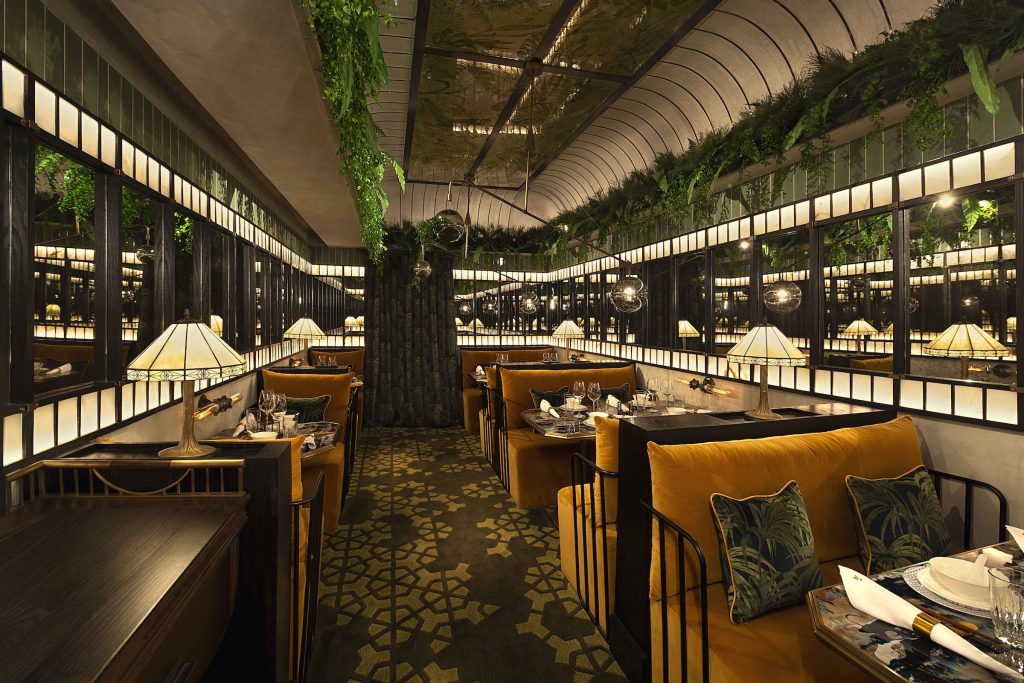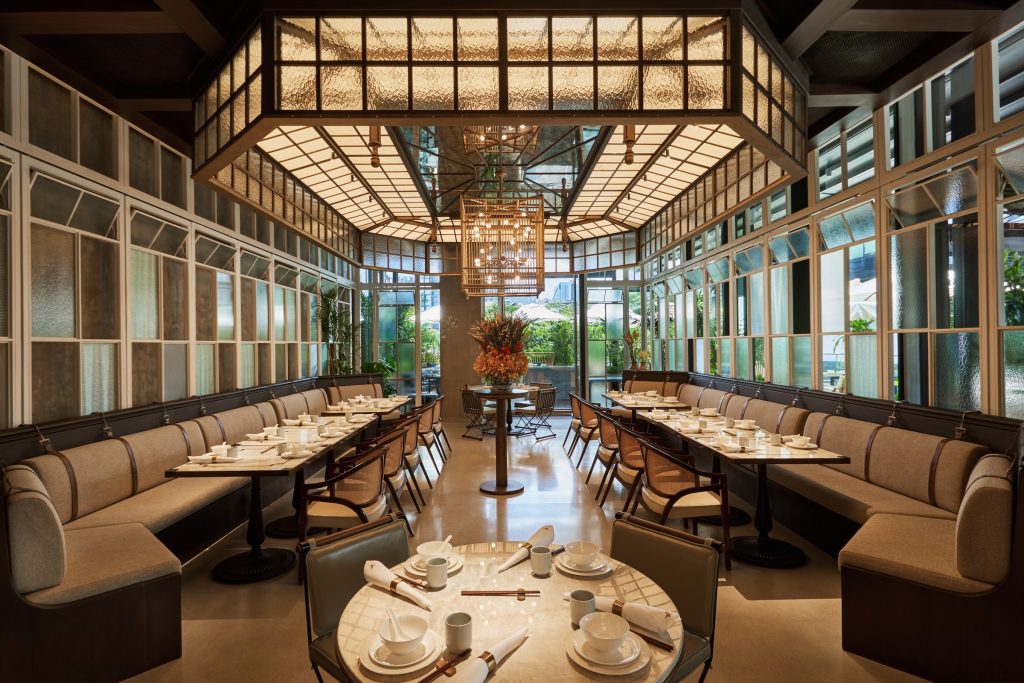Restaurants are most often lauded for outstanding culinary achievements, but when it comes to dining out, it’s not just the food that matters. Excellent service as well as an attractive atmosphere contribute greatly to an elevated experience when it comes to creating a welcoming space that discerning guests will want to revisit time and again.
Mott 32 knows a thing or two about that. First launched in Hong Kong in 2014, the sophisticated Chinese restaurant has scooped up recognition after recognition not only for its gastronomic programme, but equally importantly, for its interior design. Named after 32 Mott Street in New York, home to the city’s first Chinese convenience store, the restaurant pays homage to a slice of history through a modern lens.

In the realm of fine dining, the art of design transcends mere aesthetics—it is a symphony of culture and intention. At Mott 32, the founders, with their keen discerning eye, orchestrate every detail of the various restaurants in their portfolio, ensuring they stay true to their ethos of sharing not just the history but also the opulence and luxury of Hong Kong with the world whilst integrating key elements from the local environment. This meticulous approach is underpinned by extensive research and a dedicated in-house design team, all of whom are devoted to crafting an immersive experience that tells a unique story, blending elegance with a deep sense of place.
What gained inspiration from New York’s vibrant Chinatown and took its first steps in Hong Kong has since expanded to a multitude of cities across the globe, all while retaining the quintessential design DNA that firmly planted Mott 32 as a leading Chinese restaurant brand. For the Hong Kong outpost, Joyce Wang created a space that has become an iconic part of the Hong Kong experience. Befitting its unique location in the basement floor of a historical bank building in the heart of the city, Mott 32 Hong Kong evokes feelings of treasure vaults and elegant antiquity. A ceiling of showpiece chandeliers, eclectic lanterns, and exposed glasswork add to the deeply sumptuous appearance, the ideal backdrop to match the sophisticated dining experience..
“For the design story, what we really want to get across is the ethos and meaning behind Mott 32, what the design means, and how it has impacted global design. When we started talking to Joyce Wang, the brief we gave her is that we wanted to show Hong Kong what Hong Kong looks like today. Hong Kong is built on trade and is a city of warehouses, yet it’s also one of the most luxurious cities in the world, and there is really nothing else like it,” affirms Matt Reid, co-founder and director of Maximal Concepts.

“When we started to design Mott 32, Hong Kong was really just finding itself in a post-colonial world, and the image of Hong Kong was really undefined. We really wanted to embody Hong Kong and show the very best of every part of the city from the history to the culture and food,” Reid continues. “Design is great when it makes sense, when it makes something right for you—rarely does design have a role in influencing your view on a location.” From that point, the founders of Mott 32 set out to do exactly that.
Joyce Wang’s seminal design has bled into Mott 32s around the world, though each location retains a distinctive local influence. In Las Vegas, Wang applies a cinematic approach to match the drama and hedonism of the city, replete with neon lighting and detailing featuring Chinese embroidery and chinoiserie, as well as theatrical lighting and an oversized chandelier. A modern touch comes in the form of artist Ngai Joe-joe’s graffiti mural, adding contrast to the canvas. Las Vegas, too, has themed private rooms inspired by the setting and theme, such as the Anna Wong Room.
Cebu’s Mott 32, another Wang-designed location, marries Filipino traditional elements with the restaurant’s trademark industrial-chic style. High ceilings add to the light-filled space, framed by latticework panels, pops of botanical colour, and patterns akin to Chinese knots. Capiz shell, a common material in the Philippines, lines the bar counter.


Wang’s design continues into Seoul and Singapore, but it’s in Dubai where the East-meets-West, spice-route-influenced philosophy takes a sky-high turn. Overlooking Bluewater Island, the Jumeirah Beach Residence, Palm Jumeirah, and the Ain Dubai from the 73rd floor, Mott 32 Dubai blends the character of Arabesque courtyard houses with an open-air layout, rich foliage, and geometric tilework reminiscent of Arabic culture and history, creating an urban jungle fat above the city. Porcelain artefacts dot the semi-private Amber Room and Lotus Room, while the private Opal Room affords up to 10 guests an intimate space with clear views of the sea and iconic Dubai skyline.
Highly prized locations are the key to creating the foundations for memorable Mott 32 restaurants, and the Bangkok outpost, designed by CAP Atelier, retains the quintessential feeling of Mott 32, pairing it with an inner-city spot within the city’s The Standard, Bangkok Mahanakhon hotel, honoured with one Michelin key. Bringing the outside in, Mott 32 Bangkok is lush with botanical accents, an open terrace, and al fresco seating options, as well as three semi-private and private dining rooms.
“We took [the same] ethos into every other Mott 32 around the world and looked at the relationship between Hong Kong and this [city]. What was the story of our joint history together, what was the trade relationship, and how could we integrate this into the design? For example, one of our biggest trade relationships with [Bangkok] was silk, and this is why we have a silk loom in Mott 32 Bangkok,” Malcolm Wood, co-founder and director of Maximal Concepts, explains. “In Toronto, the steelworks are a major part of Chinatown, and this is why Mott 32 Toronto features a lot of raw steel. In Arizona, we’re looking at how to bring the desert into the design.”



In Toronto, Parts & Labor Design (PLD NYC) balances the old-world splendour of the Shangri-La hotel with the distinct DNA of Mott 32 for an antique-slash-contemporary restaurant that tells the story of Chinese craftsmanship and New York entertainment. Emerald glass, brass, delicate upholstery, custom terrazzo floors, bespoke millwork, an open kitchen, and double-height spaces add to a grand, elevated interior that complements the momentous dining experience in multifaceted ways.
“Mott 32 is really a celebration of Chinese culture,” Wood emphasises. “Around the world, it is only the Chinese that have Chinatowns—there are no ‘Englandtowns’ or ‘Americatowns.’ For the last 100 years, Chinese communities have had to huddle together to survive; the family who started 32 Mott Street did everything they could to survive and support their families back home, and for the first time, we don’t have to build a Chinese restaurant in Chinatown—we are now on the best streets and in the very best five-star hotels. For us, this is really about pride. We are the first luxury Chinese restaurant to be franchised [from] East to West and we are not in Chinatown, but on the main street, side by side with everyone else, celebrating the rise of Chinese food, art, and culture.” He adds, “When we opened Mott 32 Las Vegas, the great-grandson of 32 Mott Street came especially to thank us for honouring and recognising what they fought for and this story we really want to bring to the world.”

As Mott 32 continues its ambitious expansion around the globe—with a new opening in Arizona on the horizon, at the Ritz-Carlton, Paradise Valley, The Palmeraie, as well as upcoming outposts in Hollywood, London, Bali, and Manila—the revered gastronomic brand is poised to perpetuate its impact and culinary excellence to even more judicious diners and connoisseurs of the finest things in life.
All images courtesy of Mott 32.









